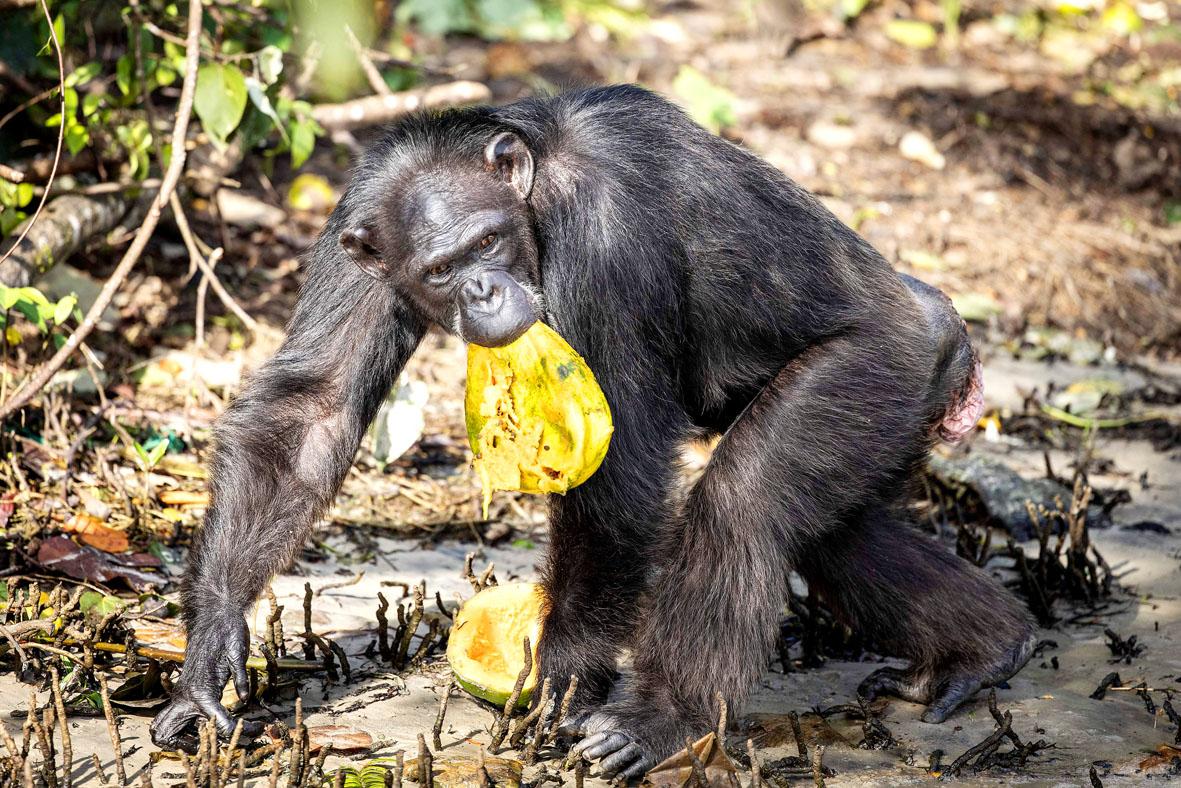Underwear-clad models stand in a rainforest, surrounded by ferns. Sunlight shines through the morning mist. “Humans,” intones renowned primatologist Jane Goodall. “What unusual animals we are.”
As the camera pans over a closeup shot of a male model’s boxer briefs, the world’s foremost expert on chimpanzees says, “It’s a big job making our world a better place, but getting started? Well, that’s as easy as changing your underwear.”
This 30-second ad, for Australian underwear company Boody, is now airing. Billboards from the campaign will soon be erected around Sydney and Melbourne.

Photo: AFP
“It’s interesting,” says Michal Carrington, a researcher in ethical consumption at Melbourne University. “Because you wouldn’t expect Dame Jane Goodall to be fronting a campaign for underwear.”
Elliot Midalia, co-managing director of Boody, says: “We didn’t want to just get any influencer or celebrity.
“Jane was the top of our list, and we’re so happy that she said yes. We couldn’t believe it.”
Goodall’s fee – a sum Boody are not contractually allowed to disclose — was paid directly to the Jane Goodall Institute.
It’s not the first time Goodall has appeared in advertising — she has also modeled for Stella McCartney and appeared in commercials for HP.
While the final cut of the commercial shows Goodall surrounded by models, the ad was shot in two parts. Goodall was filmed against a green screen in London, while the rest of the campaign footage was captured in Australia.
“She had a laugh about it, made a few jokes about how funny it was that she’d be out there with underwear models around her,” says Roy Leibowitz, one of the campaign’s creative directors. “She’s so professional, it just seemed to come easy.”
Goodall’s outfit in the advertisement was also made by Boody. Midalia says they already had plans to make a turtleneck (“her signature,” as he puts it), but when the institute confirmed she would work with the brand, “we quickly expedited that.”
Carrington describes an endorsement from Goodall as “significant.”
“Someone like Jane Goodall is not going to be part of any campaign that’s going to detract from … her credibility.”
Boody is a B Corp certified business, a 1 percent for the Planet participant, and manufacture their garments from Forest Stewardship Council-certified bamboo. Midalia describes that ad’s message as “really about sustainability, about getting people to make a switch to an underwear that supports the planet.”
While Carrington says the conservation message is important, she questions the efficacy of such a positive approach.
“Pulling my academic hat on,” she says, research suggests that when you want to engage people in an ethical decision, “no matter what the message, or the cause, you really need to switch people on morally.”
She notes that the campaign does not explain the impacts it is trying to address, from the destruction of native forests to the way cotton farming might deplete water resources. The most effective messages, Carrington says, create “what we call moral shock.”
“This ad campaign doesn’t really give that sense of moral shock, or that sense of why … The sense that people in their own actions are implicated.”
On the other hand, Carrington says, “there is a whole argument going on about how much responsibility a consumer can have.”
“While it’s great to see companies taking responsibility themselves and developing [more sustainable] products … how much responsibility do we want to place on the consumer? From a cynical perspective you could say ‘Well why isn’t there legislation out there to stop the harmful effects of clothing?’”

As Donald Trump’s executive order in March led to the shuttering of Voice of America (VOA) — the global broadcaster whose roots date back to the fight against Nazi propaganda — he quickly attracted support from figures not used to aligning themselves with any US administration. Trump had ordered the US Agency for Global Media, the federal agency that funds VOA and other groups promoting independent journalism overseas, to be “eliminated to the maximum extent consistent with applicable law.” The decision suddenly halted programming in 49 languages to more than 425 million people. In Moscow, Margarita Simonyan, the hardline editor-in-chief of the

Six weeks before I embarked on a research mission in Kyoto, I was sitting alone at a bar counter in Melbourne. Next to me, a woman was bragging loudly to a friend: She, too, was heading to Kyoto, I quickly discerned. Except her trip was in four months. And she’d just pulled an all-nighter booking restaurant reservations. As I snooped on the conversation, I broke out in a sweat, panicking because I’d yet to secure a single table. Then I remembered: Eating well in Japan is absolutely not something to lose sleep over. It’s true that the best-known institutions book up faster

The latest Formosa poll released at the end of last month shows confidence in President William Lai (賴清德) plunged 8.1 percent, while satisfaction with the Lai administration fared worse with a drop of 8.5 percent. Those lacking confidence in Lai jumped by 6 percent and dissatisfaction in his administration spiked up 6.7 percent. Confidence in Lai is still strong at 48.6 percent, compared to 43 percent lacking confidence — but this is his worst result overall since he took office. For the first time, dissatisfaction with his administration surpassed satisfaction, 47.3 to 47.1 percent. Though statistically a tie, for most

Though the total area of Penghu isn’t that large, exploring all of it — including its numerous outlying islands — could easily take a couple of weeks. The most remote township accessible by road from Magong City (馬公市) is Siyu (西嶼鄉), and this place alone deserves at least two days to fully appreciate. Whether it’s beaches, architecture, museums, snacks, sunrises or sunsets that attract you, Siyu has something for everyone. Though only 5km from Magong by sea, no ferry service currently exists and it must be reached by a long circuitous route around the main island of Penghu, with the